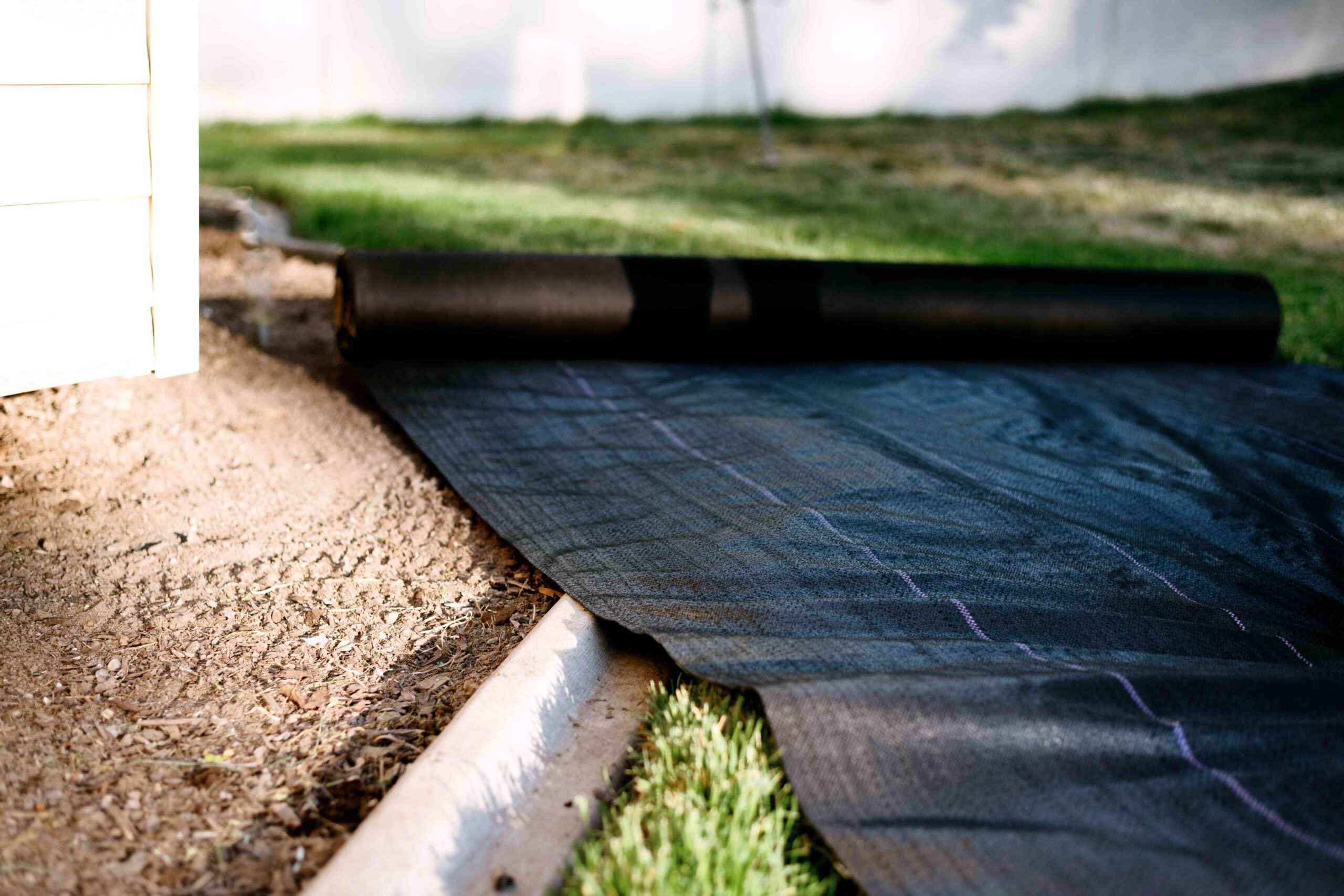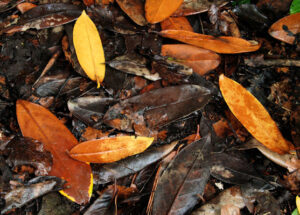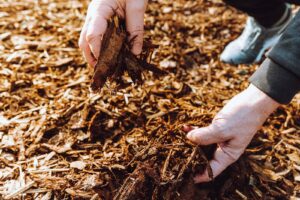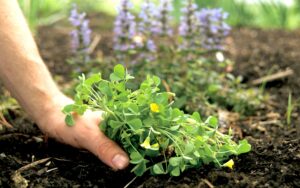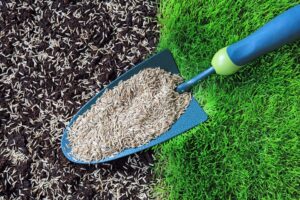How to Install Landscape Fabric for Weed Control
Are you tired of spending countless hours pulling weeds from your garden beds and landscaped areas? Landscape fabric might be the solution you’ve been looking for. This durable material creates a physical barrier that prevents weeds from sprouting while still allowing water, air, and nutrients to reach plant roots. In this comprehensive guide, you’ll learn everything you need to know about selecting, installing, and maintaining landscape fabric for effective weed control in your yard.
What Is Landscape Fabric and How Does It Work?
Landscape fabric (also called weed barrier fabric) is a geotextile material designed to suppress weed growth while allowing water and nutrients to pass through to the soil below. According to the United States Department of Agriculture Natural Resources Conservation Service, geotextiles like landscape fabric can be effective tools for soil conservation and weed management when properly installed.
This woven or non-woven synthetic material creates a physical barrier that blocks sunlight, preventing weed seeds from germinating. Most landscape fabrics are made from polypropylene, polyester, or other synthetic materials that resist degradation and can last for several years in your garden.
Types of Landscape Fabric
Before diving into installation methods, it’s important to understand the different types of landscape fabric available on the market:
- Woven Landscape Fabric: Features a tight weave that makes it extremely durable and resistant to tearing. Best for areas with heavy foot traffic or under stone hardscaping.
- Non-Woven Landscape Fabric: Has a felt-like texture and is typically more permeable than woven varieties. Ideal for vegetable gardens and flower beds where maximum water penetration is desired.
- Spun Landscape Fabric: Combines durability with excellent permeability. More expensive but often lasts longer than other types.
- Perforated Landscape Fabric: Contains pre-made holes that enhance water and air permeability. Good for areas with plants that need consistent moisture.
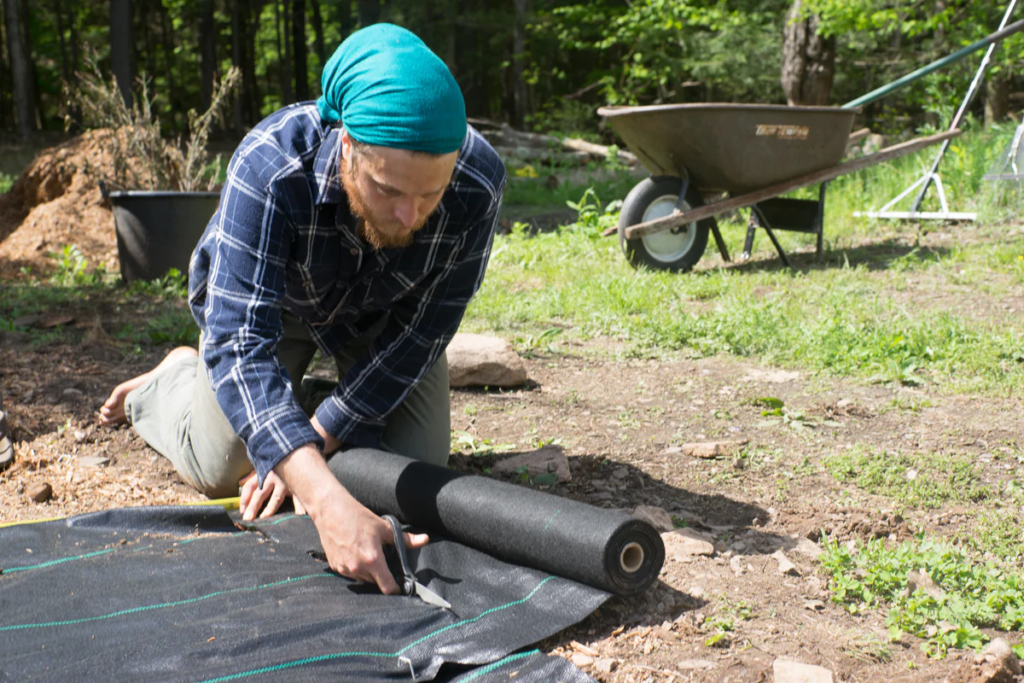
Benefits of Installing Landscape Fabric
Taking the time to properly install landscape fabric in your garden offers numerous advantages:
- Reduced Weed Growth: The primary benefit is significant reduction in weed germination and growth.
- Soil Moisture Conservation: Fabric helps retain soil moisture by reducing evaporation.
- Improved Soil Temperature Regulation: Acts as an insulator, keeping soil temperatures more stable.
- Erosion Control: Prevents soil erosion, especially on slopes or in areas with heavy rainfall.
- Reduced Need for Herbicides: Decreases reliance on chemical weed control methods.
- Clean Separation Between Soil and Mulch: Creates a barrier that prevents mulch from mixing with soil over time.
Materials and Tools You’ll Need
Before starting your landscape fabric installation project, gather these essential supplies:
Materials:
- Landscape fabric (calculate square footage needed plus 10% extra)
- Landscape fabric pins/staples (approximately one pin per square foot)
- Mulch, decorative rock, or other top dressing (2-3 inches deep)
- Additional soil or compost (if needed)
Tools:
- Garden rake
- Sharp scissors or utility knife
- Measuring tape
- Garden gloves
- Small sledgehammer (for securing pins in hard soil)
- String or spray paint (for marking areas)
- Wheelbarrow
- Hand trowel
Step-by-Step Installation Process
1. Prepare the Area
Proper preparation is crucial for effective landscape fabric installation:
- Clear the area completely: Remove all existing weeds, rocks, sticks, and debris from the soil surface.
- Identify existing plants to keep: Mark plants you want to preserve so you can cut openings for them later.
- Level the soil surface: Use a rake to create a smooth, even surface with no dips or mounds.
- Apply pre-emergent herbicide (optional): For extra protection, consider applying a pre-emergent herbicide following the EPA guidelines for herbicide application.
- Add soil amendments if needed: If your soil needs improvement, incorporate compost or other amendments before laying the fabric.
2. Measure and Cut the Fabric
Accurate measurement ensures you don’t waste material or leave gaps where weeds can emerge:
- Measure the area: Use a tape measure to determine the dimensions of your garden bed or landscape area.
- Add overlap allowance: Add 6-12 inches to each dimension to allow for overlap where pieces meet.
- Cut the fabric: Using sharp scissors or a utility knife, cut the fabric to size on a clean, flat surface.
- Plan for multiple pieces if necessary: For large areas, plan how pieces will overlap (minimum 6-inch overlap recommended).
3. Position the Landscape Fabric
Proper positioning is essential for effective weed control:
- Roll out the fabric: Start at one end of the prepared area and slowly roll out the fabric across the soil.
- Position with dark side down: Most landscape fabrics have a dark side that should face the soil.
- Allow fabric to relax: Let the fabric sit for a few minutes to reduce wrinkles and conform to the ground.
- Cut holes for existing plants: For plants you’re keeping, cut X-shaped holes in the fabric where plants will protrude.
- Smooth out wrinkles: Press the fabric firmly against the soil, removing air pockets and wrinkles.
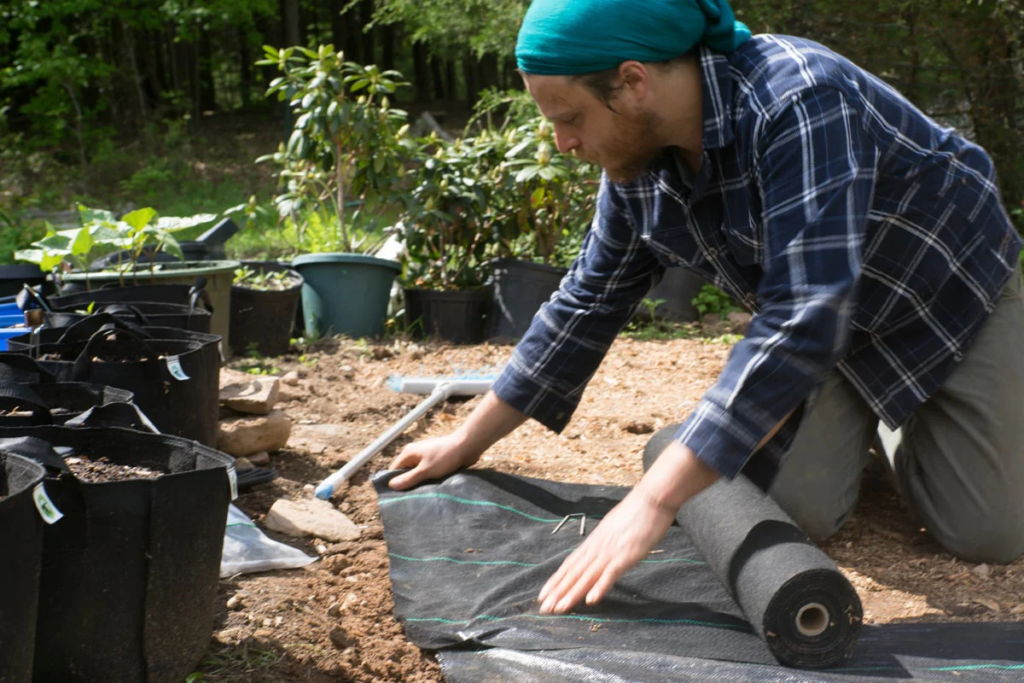
4. Secure the Fabric
Proper anchoring prevents the fabric from shifting or blowing away:
- Start securing at one end: Begin by placing pins along one edge, working your way across.
- Space pins appropriately: Place pins approximately 8-12 inches apart around the perimeter and 2-3 feet apart in the middle sections.
- Secure overlaps thoroughly: Use extra pins at overlapping sections to prevent gaps from forming.
- Pin around plant openings: Place pins near cuts made for plants to prevent fabric from tearing further.
5. Cover with Mulch or Decorative Material
Adding a top layer protects the fabric and enhances your landscape’s appearance:
- Choose appropriate covering material: Select mulch, decorative rock, or other materials that complement your landscape design.
- Apply 2-3 inches of material: Cover the entire fabric surface with an even layer of your chosen material.
- Keep material away from plant stems: Leave a small gap around plant stems to prevent rot.
Landscape Fabric Performance Comparison
When selecting landscape fabric, consider how different types perform in various applications:
| Fabric Type | Weed Suppression | Water Permeability | Durability | Best Uses | Avg. Lifespan |
|---|---|---|---|---|---|
| Woven | Excellent | Good | Excellent | Paths, under hardscaping | 10-15 years |
| Non-woven | Very good | Excellent | Good | Garden beds, around plants | 3-5 years |
| Spun | Excellent | Very good | Very good | General landscaping | 5-10 years |
| Perforated | Good | Excellent | Good | Plant-heavy areas | 2-4 years |
| Biodegradable | Fair | Excellent | Poor | Temporary applications | 1-2 years |
Common Installation Mistakes to Avoid
Even experienced gardeners can make these common landscape fabric installation errors:
Not Preparing the Ground Properly
Skipping thorough weed removal before installation is perhaps the biggest mistake. Any existing weeds left under the fabric can still grow and eventually push through or around the material. Take the time to remove ALL weeds, including their roots, before laying fabric.
Insufficient Overlap Between Pieces
When using multiple pieces of landscape fabric, failing to create adequate overlap (minimum 6 inches) creates vulnerable seams where weeds can emerge. Always plan for generous overlap and secure these areas with extra pins.
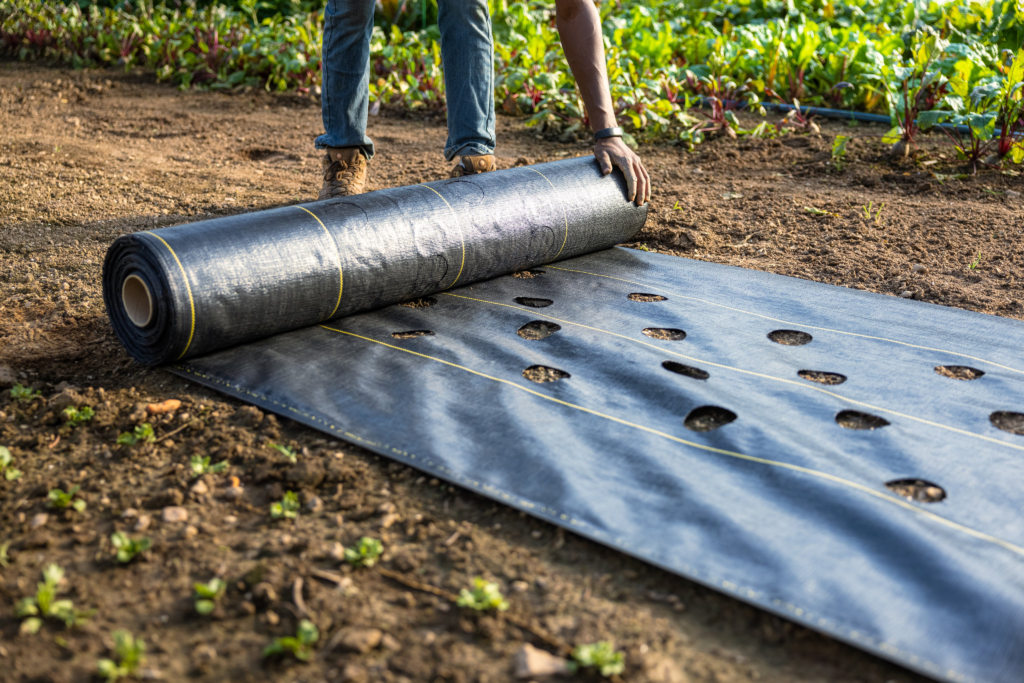
Exposing Fabric to Sunlight
Leaving landscape fabric exposed to UV rays accelerates its degradation. Always cover the entire surface with mulch or other materials to protect the fabric from sunlight, which can cause it to break down prematurely.
Using the Wrong Type for Your Application
Not all landscape fabrics are created equal. Using lightweight fabric in high-traffic areas or heavy-duty fabric where water permeability is crucial can lead to disappointing results. Match the fabric type to your specific needs.
Insufficient Pinning
Under-securing the fabric allows it to shift, creating gaps and exposed areas. Be generous with landscape pins, especially along edges and at overlaps.
Maintaining Landscape Fabric for Long-Term Effectiveness
With proper care, your landscape fabric installation can provide years of weed control:
Regular Inspection and Repair
- Check for tears or damage: Periodically inspect the fabric, especially after severe weather events.
- Patch holes promptly: Use landscape fabric patches or tape designed for this purpose to repair any damages.
- Re-secure loose edges: Add pins where needed to keep edges firmly in place.
Mulch Replenishment
- Maintain proper mulch depth: Add fresh mulch annually to maintain the recommended 2-3 inch depth.
- Remove accumulated organic matter: Clear leaves and other debris that could decompose and create a growing medium for weeds on top of the fabric.
Dealing with Persistent Weeds
Despite your best efforts, some weeds may still appear:
- Remove top-growing weeds promptly: Pull any weeds that manage to grow in the mulch layer before they can establish deep roots.
- Spot-treat with herbicide if necessary: For stubborn weeds, carefully apply herbicide only to the weed itself, avoiding surrounding plants.
- Address edge intrusion: Pay special attention to fabric edges where weeds often find entry points.
Landscape Fabric Alternatives
While landscape fabric is effective, you might consider these alternatives for specific situations:
Organic Mulch Layering
Applying thick layers (4+ inches) of organic mulch like wood chips or bark can suppress weeds without fabric. This approach improves soil over time as the mulch breaks down, but requires more frequent replenishment.
Cardboard or Newspaper Sheet Mulching
Laying overlapping sheets of cardboard or multiple layers of newspaper before adding mulch provides temporary weed suppression while improving soil as it decomposes. The USDA Sustainable Agriculture Research and Education program provides guidelines for effective sheet mulching techniques.
Living Ground Covers
Planting dense, low-growing plants that spread to cover soil can naturally suppress weeds while adding beauty to your landscape. Options include creeping thyme, sweet woodruff, or ajuga.
Regular Hand Weeding and Cultivation
For smaller areas or vegetable gardens where fabric might not be ideal, consistent hand weeding coupled with shallow cultivation can effectively manage weeds without barriers.
When to Avoid Using Landscape Fabric
While landscape fabric has many benefits, it’s not suitable for all situations:
- Annual flower or vegetable beds: Areas that require frequent replanting or soil access are not ideal for landscape fabric.
- Gardens focusing on soil building: Landscape fabric can interfere with natural processes that build healthy soil.
- Areas with aggressive perennial weeds: Some persistent weeds like nutsedge can penetrate most fabrics.
- Self-seeding plant gardens: Gardens where you want plants to spread naturally through seed dispersal won’t work well with fabric barriers.
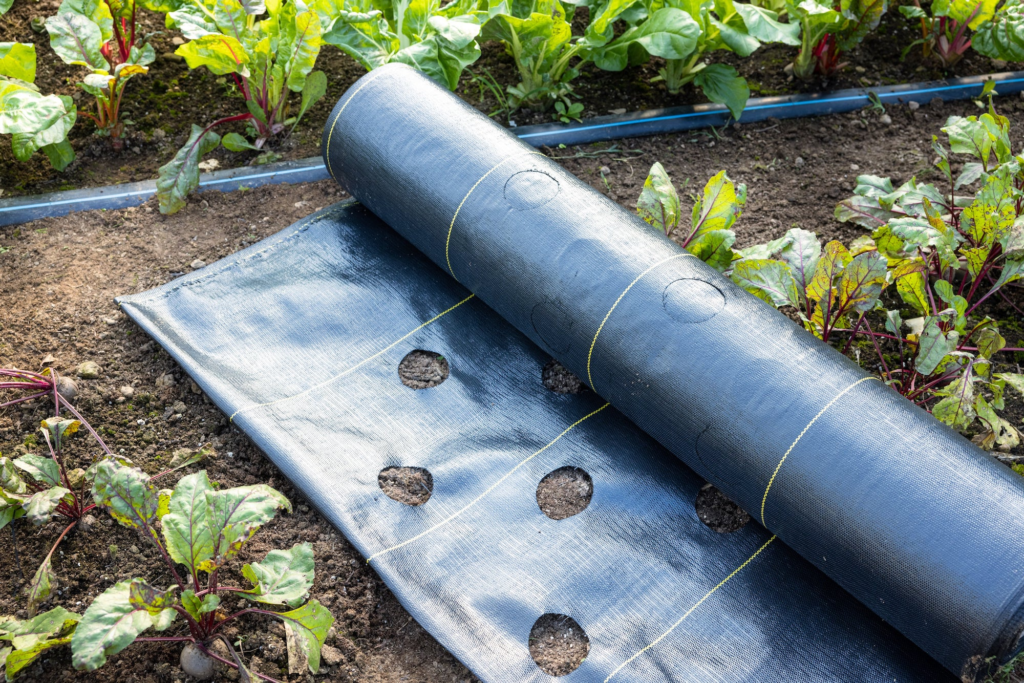
Environmental Considerations
When using synthetic materials in your garden, keep these environmental factors in mind:
Sustainability Concerns
Most landscape fabrics are made from petroleum-based products that don’t biodegrade. Consider biodegradable alternatives for temporary installations or in environmentally sensitive areas.
Impact on Soil Ecology
While permeable fabrics allow water through, they can affect soil biology by limiting organic matter incorporation and reducing earthworm movement. In natural areas, these impacts should be carefully considered.
Proper Disposal at End of Life
When landscape fabric eventually needs replacement, dispose of it properly according to local regulations for synthetic materials. Some municipalities have specific guidelines for garden waste containing synthetic materials.
Case Study: Before and After Installation
Many homeowners report dramatic reductions in weeding time after proper landscape fabric installation. For example, a typical suburban front yard garden bed (approximately 200 square feet) that previously required weekly weeding throughout the growing season might need attention only monthly or less after fabric installation, representing an 80% reduction in maintenance time.
The initial investment in quality landscape fabric, pins, and mulch can pay for itself within 1-2 seasons through reduced labor, water conservation, and elimination of weed control products.
Conclusion
Installing landscape fabric is a proven method for gaining the upper hand in your battle against garden weeds. By following the proper preparation and installation techniques outlined in this guide, you can create a low-maintenance landscape that stays relatively weed-free for years to come.
Remember that the key to success lies in thorough ground preparation, selecting the right fabric for your specific needs, proper installation technique, and consistent maintenance. With these elements in place, you’ll spend less time pulling weeds and more time enjoying your beautiful landscape.
For additional information on sustainable landscaping practices, visit the EPA’s GreenScapes program, which offers resources for environmentally friendly landscape management.
